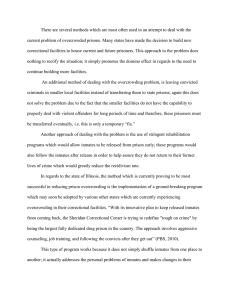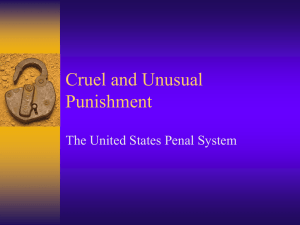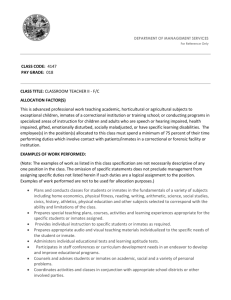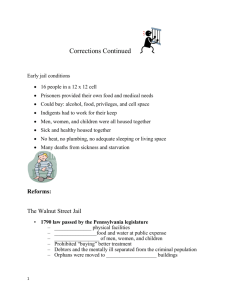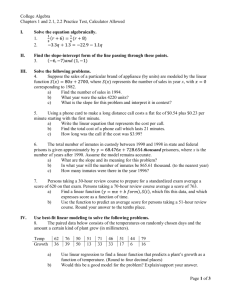Chapter 12
advertisement
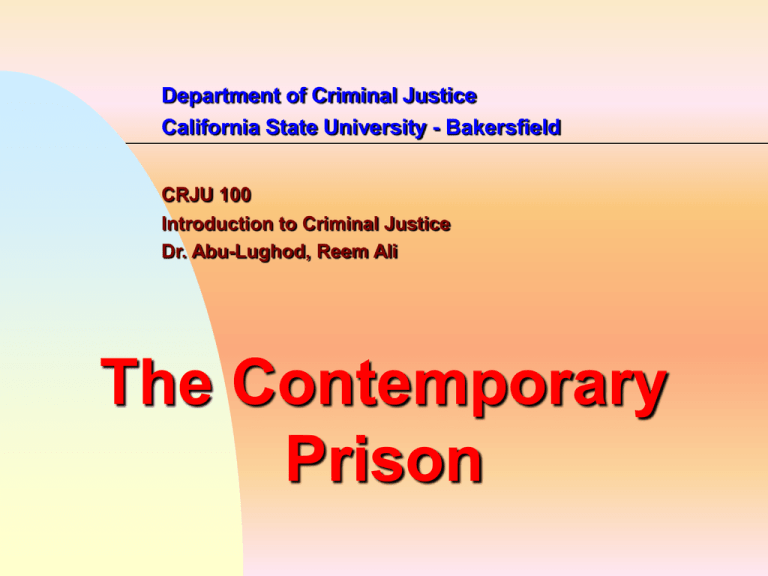
Department of Criminal Justice California State University - Bakersfield CRJU 100 Introduction to Criminal Justice Dr. Abu-Lughod, Reem Ali The Contemporary Prison Intro: Prison Life: Erving Goffman called it a “total institution” Purpose: order and efficiency Gresham Sykes: The Soc of Captives. Argued that max security is painful because it deprives inmates from freedom, destructs their psyche, personality Described 5 pains of imprisonment: 1) deprivation of liberty, 2) dep of good and services, 3) dep of heterosexual relationships (rape), 4) dep of autonomy (rules and regulations), 5) dep of security (most disturbing) Inmate Subculture: developing “argot” roles 1) Rats (betray inmates) and Center men (will not betray) 2) Gorillas (take good by forces) and Merchants (trades for goods) 3) Wolves (masculine roles), Punks (weaker, forced to engage in homo acts) and Fags (feminine)…relieving lack of heterosexual behavior 4) Ball-busters (disobedient to admin), and real men (respected by other inmates, dignity) 5) Toughs (violence for the sake violence) and Hipsters (talk the talk but don’t walk the walk) The above mentioned “argot” roles are ideal type roles created by Sykes PRISON GANGS: Primary focus on the California prison gangs because they have been the most serious Structure primarily based on race 1) Mexican Mafia 1950s groups of Mexs from LA 2) La Nuestra Familia: at odds with MM, code of honor, street recruitment when releases 3) Black Guerilla Family 1960s: political ideologies, Marxists views and perspectives 4) Aryan Brotherhood: white gang members, among most violent, sometimes join La Nuestra Familia against MM WHAT SHOULD WE DO WITH THE GROWING PRISON GANGS? HOW SHOULD THE AMDIN DEAL WITH THEM? ETC… One response to prison gangs in California was to build expensive prisons where inmates were separated from one another Pelican Bay State Prison Max-sec in Crescent City, CA Sep-silent systems Inmates suffer depression, suicidal attempts, etc… Escorted to perform certain activities Advantages: safety for society, locking dangerous offenders up Applies technology to maintain order, but it’s expensive to operate, and have long term psychological consequences Prison Riots and Violence: Frustration and isolations: writing letters, etc… Collective behavior in prison What do we as members of soc do when we are frustrated versus prison inmates ATTICA PRISON RIOTS 1971: Investigated primarily by McKay Commission. Interviewed guards, inmates, state police, reporters and former Governor Nelson Rockefeller It was in upstate NY 1931 Many social movements taking place outside of prison Some concerned with civil rights, women’s liberation, family values. Government being challenged by people Also inmates felt that incarceration conditions were unjust and unconstitutional protested NEW MEXICO STATE PENITENTIARY RIOT 1980 33 inmates died in a riot at New Mexico State Pen in Santa Fe 12 guards severely beaten/raped NM riot: inmates had no social cohesion Some inmates took advantage of other inmates, raped them, etc… Today its easier to separate inmates who cause problems. e.g. some prisons have SORT (special operation response team) unit similar to SWAT (special weapon and tactics) in LE WORKING IN PRISON Guards, medical techs, admins, secretaries Most problematic is correctional officer: Lombardo (scholar of prison, lists 7 variations of CO job assignments) 1) Block officers: security, order, feeding inmates, mail 2) Work detail supervisors: supervising inmate activity 3) industrial shop and school officers: perform security and order maintenance functions, supervise inmates engaged in school act Yard officers: most problems with inmates may occur here Administrative building assignments: little contact with inmates, supervise visitations, etc.. 6) wall posts: watching from tower on top to make sure everything is in order 7) relief officers: fill in for officers who take off, subs OVERALL FUNCTIONS OF CO: 1) Human services: referral agents 2) Order maintenance: trust and cooperation 3) Security: inmates in control 4) Supervision: efficiency and safety Courts and the Prison: Should inmates have legal rights while they are incarcerated? Controversial because they have forfeited their rights as citizens Prior to 1960s courts had a “hand off doctrine” towards inmates’ rights because 1) confinement was technical matter that judges were not educationally equipped to consider 2) because of separation of powers, decisions about prisons considered matter of executive branch of government not judicial 3) public did not care about what went on in prison 4) treatment of prisoners was a product of privileges rather than legal rights THEN SOCIAL MOVEMENTS IN 1960s ONWARD: people became more aware of their rights Inmates allowed to sue for civil rights th Am: “….no cruel or unusual punishments be 8 inflicted”. But what is cruel and unusual th Am: due process…when inmates are 14 segregated, should this concern the courts? 14th Am equal protection………to help define inmates’ rights, racial and gender based discrimination in the prison, religious freedom PRIVATE PRISONS: Interest in privatizing prisons began in mid-1970s and the first modern private prisons opened in early 1980s U.S. was suffering from gas and oil shortages, increase in crime rate, economic recession Therefore government not as popular, inefficient even in running prisons Idea was that private firms can handle prisons more efficiently 1) corrections corporation of America (CCA) 1983 services Government cant do anything very well 2003: operated 60 U.S. jails and prisons, 53,000 inmates. Revenues in 2002 $962.8 mil 2) Wackenhut corrections corporation (WCC) 1984 Runs 35 facilities in U.S. and internationally in Australia, Canada, New Zealand, England Designs, builds, finances and manages prisons Provides immigration and detection services to U.S. Dept. of Homeland Security and U.S. Marshalls. Revenues 2002 $568.6 mil 3) Correctional services corporation (CSC) 1993 Operates 11 adult correctional facilities 18 juv facilities 2002 revenues $160.4 mil Arguments for private prisons: 1) money (efficiency) 2) Better employee control (hiring and firing) 3) Flexibility and accountability Arguments Against: 1) Money: what about inmate welfare v. profit 2) Labor: threaten jobs of public employees 3) Control: weakening parole alternatives, and control over human beings


